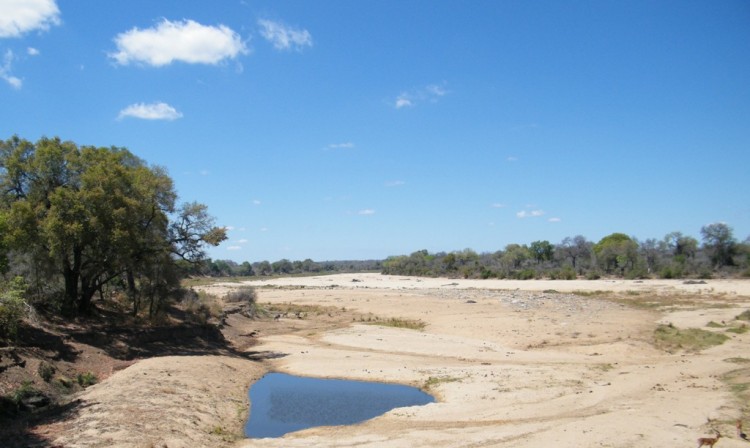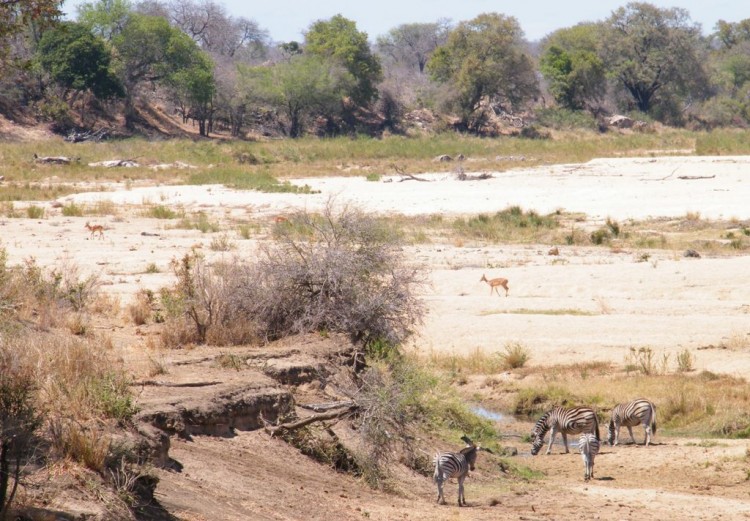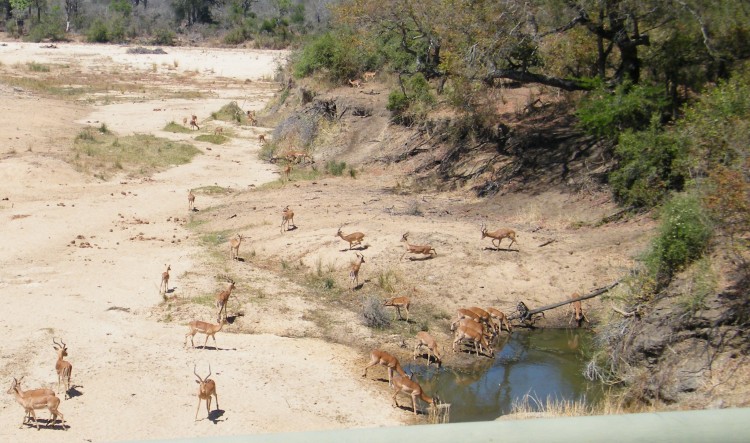Here is one with the Sand River in the background, and lions around!
Flavour of the Month - April/May 2020 H1-2 Skukuza - Tshokwane (incl all dams)
- Richprins
- Committee Member
- Posts: 75269
- Joined: Sat May 19, 2012 3:52 pm
- Location: NELSPRUIT
- Contact:
Re: Flavour of the Month - April/May 2020 H1-2 Skukuza - Tshokwane (incl all dams)
Even in driest times one can see the sausage tree in full foliage! 

Here is one with the Sand River in the background, and lions around!
Here is one with the Sand River in the background, and lions around!
Please check Needs Attention pre-booking: https://africawild-forum.com/viewtopic.php?f=322&t=596
- Richprins
- Committee Member
- Posts: 75269
- Joined: Sat May 19, 2012 3:52 pm
- Location: NELSPRUIT
- Contact:
Re: Flavour of the Month - April/May 2020 H1-2 Skukuza - Tshokwane (incl all dams)
Another quite regular attraction along the Sand River stretch is where the vultures come to bathe.
I have seen this more than once, on the sandbanks near where the Mutlumhuvi Stream joins up!
I have seen this more than once, on the sandbanks near where the Mutlumhuvi Stream joins up!
Please check Needs Attention pre-booking: https://africawild-forum.com/viewtopic.php?f=322&t=596
- Flutterby
- Posts: 44029
- Joined: Sat May 19, 2012 12:28 pm
- Country: South Africa
- Location: Gauteng, South Africa
- Contact:
Re: Flavour of the Month - April/May 2020 H1-2 Skukuza - Tshokwane (incl all dams)
We've seen Bateleurs in the same area....about 20 of them together! 
- Alf
- Posts: 10705
- Joined: Wed Nov 26, 2014 12:40 pm
- Country: south africa
- Location: centurion
- Contact:
Re: Flavour of the Month - April/May 2020 H1-2 Skukuza - Tshokwane (incl all dams)
We have also seen the vultures there a few times wondering what they up to
Next trip to the bush??
Let me think......................
Let me think......................
- Lisbeth
- Site Admin
- Posts: 65801
- Joined: Sat May 19, 2012 12:31 pm
- Country: Switzerland
- Location: Lugano
- Contact:
Re: Flavour of the Month - April/May 2020 H1-2 Skukuza - Tshokwane (incl all dams)
I have seen vultures like that, but next to the Sabie River Bridge and was also wondering, what they were doing. Now I know 
"Education is the most powerful weapon which you can use to change the world." Nelson Mandela
The desire for equality must never exceed the demands of knowledge
The desire for equality must never exceed the demands of knowledge
- Richprins
- Committee Member
- Posts: 75269
- Joined: Sat May 19, 2012 3:52 pm
- Location: NELSPRUIT
- Contact:
Re: Flavour of the Month - April/May 2020 H1-2 Skukuza - Tshokwane (incl all dams)
Another loop on the river side of the road! 
Nyala have been seen more and more over the years, but have no business being here...they came in from adjoining private game farms...
Nyala have been seen more and more over the years, but have no business being here...they came in from adjoining private game farms...
Please check Needs Attention pre-booking: https://africawild-forum.com/viewtopic.php?f=322&t=596
- Richprins
- Committee Member
- Posts: 75269
- Joined: Sat May 19, 2012 3:52 pm
- Location: NELSPRUIT
- Contact:
Re: Flavour of the Month - April/May 2020 H1-2 Skukuza - Tshokwane (incl all dams)
The Mutlumhuvi bridge has lovely views in the dry season! 




Please check Needs Attention pre-booking: https://africawild-forum.com/viewtopic.php?f=322&t=596
- Lisbeth
- Site Admin
- Posts: 65801
- Joined: Sat May 19, 2012 12:31 pm
- Country: Switzerland
- Location: Lugano
- Contact:
Re: Flavour of the Month - April/May 2020 H1-2 Skukuza - Tshokwane (incl all dams)
Nice pic of the impalas 
"Education is the most powerful weapon which you can use to change the world." Nelson Mandela
The desire for equality must never exceed the demands of knowledge
The desire for equality must never exceed the demands of knowledge
- Richprins
- Committee Member
- Posts: 75269
- Joined: Sat May 19, 2012 3:52 pm
- Location: NELSPRUIT
- Contact:
Re: Flavour of the Month - April/May 2020 H1-2 Skukuza - Tshokwane (incl all dams)
Shiloweni Dam (Silolweni)
Silolweni
This Tsonga word refers to an area being swampy in the
rainy season. The name was given to a spruit tributary to the
N’waswitsontso - Vd Wateren
This was the only other dam long the road, and was destroyed in 2008 due to a poisonous outbreak of blue-green algae there! (Kruger had begun destroying dams anyway as part of a renaturalisation process, which still remains confused to be honest).
The medium-sized dam, built in 1971/2, is no longer accessible but can be seen from the tar road. It was the nearest dam to Tshokwane and extremely popular with tourists and a plethora of game alike. During the 1992 drought we saw a total of 13 mammal species including 4 of the big 5 there at one sitting, plus a double lion kill!

This satpic shows how the comprehensive earthworks wiped the dam wall out. (Large parking lot at top right)
Here are some pics from 2011 courtesy of amoli:
Silolweni
This Tsonga word refers to an area being swampy in the
rainy season. The name was given to a spruit tributary to the
N’waswitsontso - Vd Wateren
This was the only other dam long the road, and was destroyed in 2008 due to a poisonous outbreak of blue-green algae there! (Kruger had begun destroying dams anyway as part of a renaturalisation process, which still remains confused to be honest).
The medium-sized dam, built in 1971/2, is no longer accessible but can be seen from the tar road. It was the nearest dam to Tshokwane and extremely popular with tourists and a plethora of game alike. During the 1992 drought we saw a total of 13 mammal species including 4 of the big 5 there at one sitting, plus a double lion kill!
This satpic shows how the comprehensive earthworks wiped the dam wall out. (Large parking lot at top right)
Here are some pics from 2011 courtesy of amoli:
Please check Needs Attention pre-booking: https://africawild-forum.com/viewtopic.php?f=322&t=596
- Richprins
- Committee Member
- Posts: 75269
- Joined: Sat May 19, 2012 3:52 pm
- Location: NELSPRUIT
- Contact:
Re: Flavour of the Month - April/May 2020 H1-2 Skukuza - Tshokwane (incl all dams)
The algae stories:
Algae Kills Again in Kruger
The death toll caused by blooms of blue-green algae, Microcystis, in some of Kruger's waterpoints has increased. Subsequent to the die-offs reported at Shilolweni dam in the Tshokwane section earlier this year, an additional impala (positively identified as dying of algal poisoning) and other carcasses, including a giraffe, have been found in the section.
More recently a fresh carcass of a white rhino bull was found and linked to an algal bloom in Sunset Dam near in the Lower Sabie section. Sunset Dam has had an algal bloom for the last three years, and this is the first fatality recorded at the dam. One reason for the almost complete lack of fatalities is that the Sabie River runs about 50 metres from the dam on its way to Mozambique. The animals probably prefer the cleaner Sabie water to the water in Sunset Dam.
Blue-green algae, or cyanobacteria, is one of the oldest known organisms on earth and is found in most water bodies in low numbers. However, under the right conditions they multiply to produce algal blooms, great masses of algae that discolour the water. The algae produce strong poisons, which can damage the nervous system and the liver of animals. In the case of an algal bloom, these toxins concentrate in the water at much higher levels than normally occur. Animals can be poisoned if they drink water containing enough Microcystis.
Previously the Park has breached the damwall of the Nhlanganzwane Dam near Crocodile Bridge rest camp after over 50 animal carcasses were recorded in 2005, plus more fatalities in 2007. This year Kruger rangers and technical services staff drained the Shilolweni dam to combat the algal bloom that caused a number of fatalities earlier this year. According to Freek Venter, head of conservation services in Kruger, the nutrient rich silt in the Shiloweni dam will be removed.
The 100 strong hippo population has moved to a stream east of the dam and to the nearby Orpen Dam. The park has decided on a different intervention to combat the algae bloom at Sunset Dam. Freek believes that draining the water will be less effective than as at Shilolweni Dam as the Sabie River is too close to Sunset and a preferred alternative for the 100 or so hippo in the area. The dam also attracts a huge tourist contingent. It was thus decided to pump water into Sunset Dam with the intention of diluting the bloom.
"If this does not work, we will probably have to consider draining the dam, as well," says Freek. He is reluctant to use a chemical option as "this will be a very temporary" solution. Several Kruger dams are due for destruction in terms of the park's rehabilitation and wilderness policies, as well as a transfrontier conservation area agreement that stipulates there will be no man made water structures in a 10 kilometre zone on either sides of the national borders.
By Lynette Strauss
http://www.krugerpark.co.za/krugerpark- ... 24877.html
Kruger Park draining death dam
2008-04-15 20:05
Johannesburg - Conservation authorities began to drain the Silolweni Dam on Tuesday to prevent algal poisoning of the wildlife in the area, said the Kruger National Park.
The decision was made after conservation officials and rangers found five zebra carcasses near the Tshokwane picnic site and suspected that blue-green algae (cyano bacteria) was responsible for the deaths.
This was confirmed after full post-mortems were done on two carcasses - by state veterinarian Roy Bengis - and water samples from the dam revealed a high concentration of the algae.
"We understand that the large concentration of this algal poison was built up due to the high concentration of hippo in the dam
"... we have found that the most-effective way to discourage the hippos from visiting the dam is to lower the level of the water," said Freek Venter, the park's head of conservation management.
Want permanent solution
The grass around the dam was also burnt, before the draining, to discourage animals from grazing near it.
The pump apparatus will be visible from the H1-2 tar road between Skukuza and Tshokwane and the tourist parking area near the dam.
Silolweni Dam is popular as a game-viewing site and is visited by thousands of tourists every year, the park said.
"A number of options were considered before it was decided to drain the dam using floating pumps set up in the middle of the dam.
"As this is the second case in the last 12 months when algal poisoning has caused multiple animal deaths, we are looking at permanent solutions to the problem," said Venter.
The Nhlanganzwane Dam near Crocodile Bridge Rest Camp was breached in July 2007 after it was discovered that the same algal poisoning had killed more than 54 animals.
https://www.news24.com/SouthAfrica/News ... m-20080415
Algae Kills Again in Kruger
The death toll caused by blooms of blue-green algae, Microcystis, in some of Kruger's waterpoints has increased. Subsequent to the die-offs reported at Shilolweni dam in the Tshokwane section earlier this year, an additional impala (positively identified as dying of algal poisoning) and other carcasses, including a giraffe, have been found in the section.
More recently a fresh carcass of a white rhino bull was found and linked to an algal bloom in Sunset Dam near in the Lower Sabie section. Sunset Dam has had an algal bloom for the last three years, and this is the first fatality recorded at the dam. One reason for the almost complete lack of fatalities is that the Sabie River runs about 50 metres from the dam on its way to Mozambique. The animals probably prefer the cleaner Sabie water to the water in Sunset Dam.
Blue-green algae, or cyanobacteria, is one of the oldest known organisms on earth and is found in most water bodies in low numbers. However, under the right conditions they multiply to produce algal blooms, great masses of algae that discolour the water. The algae produce strong poisons, which can damage the nervous system and the liver of animals. In the case of an algal bloom, these toxins concentrate in the water at much higher levels than normally occur. Animals can be poisoned if they drink water containing enough Microcystis.
Previously the Park has breached the damwall of the Nhlanganzwane Dam near Crocodile Bridge rest camp after over 50 animal carcasses were recorded in 2005, plus more fatalities in 2007. This year Kruger rangers and technical services staff drained the Shilolweni dam to combat the algal bloom that caused a number of fatalities earlier this year. According to Freek Venter, head of conservation services in Kruger, the nutrient rich silt in the Shiloweni dam will be removed.
The 100 strong hippo population has moved to a stream east of the dam and to the nearby Orpen Dam. The park has decided on a different intervention to combat the algae bloom at Sunset Dam. Freek believes that draining the water will be less effective than as at Shilolweni Dam as the Sabie River is too close to Sunset and a preferred alternative for the 100 or so hippo in the area. The dam also attracts a huge tourist contingent. It was thus decided to pump water into Sunset Dam with the intention of diluting the bloom.
"If this does not work, we will probably have to consider draining the dam, as well," says Freek. He is reluctant to use a chemical option as "this will be a very temporary" solution. Several Kruger dams are due for destruction in terms of the park's rehabilitation and wilderness policies, as well as a transfrontier conservation area agreement that stipulates there will be no man made water structures in a 10 kilometre zone on either sides of the national borders.
By Lynette Strauss
http://www.krugerpark.co.za/krugerpark- ... 24877.html
Kruger Park draining death dam
2008-04-15 20:05
Johannesburg - Conservation authorities began to drain the Silolweni Dam on Tuesday to prevent algal poisoning of the wildlife in the area, said the Kruger National Park.
The decision was made after conservation officials and rangers found five zebra carcasses near the Tshokwane picnic site and suspected that blue-green algae (cyano bacteria) was responsible for the deaths.
This was confirmed after full post-mortems were done on two carcasses - by state veterinarian Roy Bengis - and water samples from the dam revealed a high concentration of the algae.
"We understand that the large concentration of this algal poison was built up due to the high concentration of hippo in the dam
"... we have found that the most-effective way to discourage the hippos from visiting the dam is to lower the level of the water," said Freek Venter, the park's head of conservation management.
Want permanent solution
The grass around the dam was also burnt, before the draining, to discourage animals from grazing near it.
The pump apparatus will be visible from the H1-2 tar road between Skukuza and Tshokwane and the tourist parking area near the dam.
Silolweni Dam is popular as a game-viewing site and is visited by thousands of tourists every year, the park said.
"A number of options were considered before it was decided to drain the dam using floating pumps set up in the middle of the dam.
"As this is the second case in the last 12 months when algal poisoning has caused multiple animal deaths, we are looking at permanent solutions to the problem," said Venter.
The Nhlanganzwane Dam near Crocodile Bridge Rest Camp was breached in July 2007 after it was discovered that the same algal poisoning had killed more than 54 animals.
https://www.news24.com/SouthAfrica/News ... m-20080415
Please check Needs Attention pre-booking: https://africawild-forum.com/viewtopic.php?f=322&t=596


